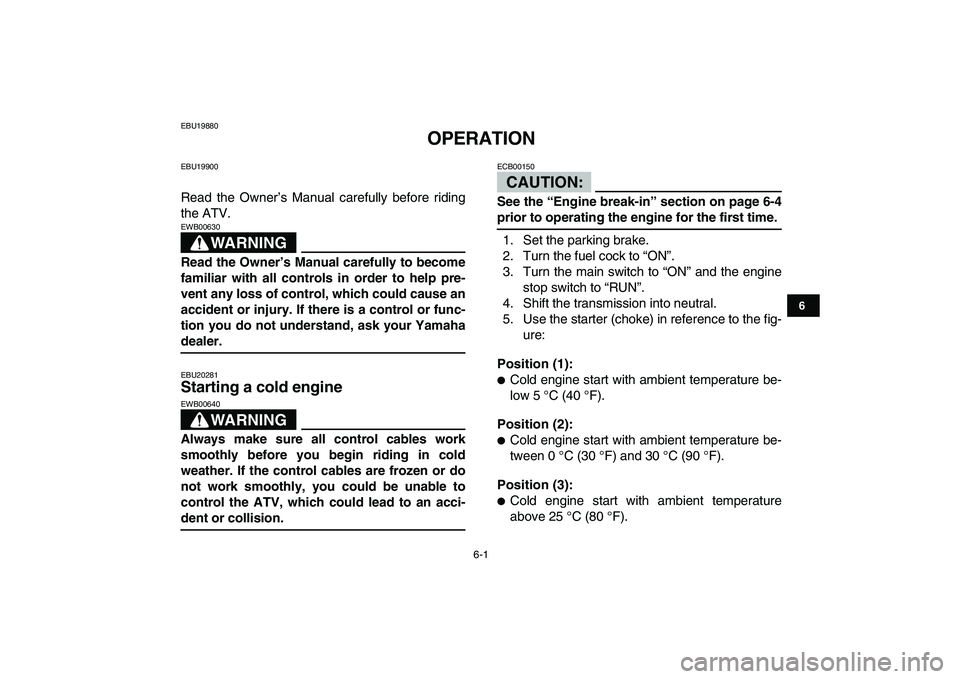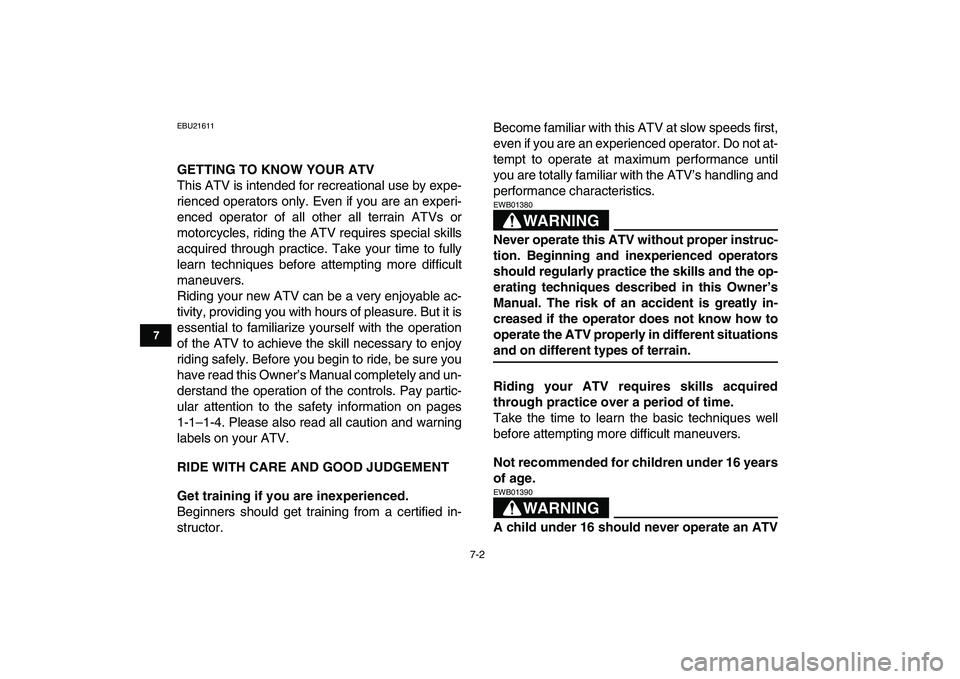Page 47 of 140

6-1
1
2
3
4
56
7
8
9
10
11
EBU19880
OPERATION
EBU19900
Read the Owner’s Manual carefully before riding
the ATV.
WARNING
EWB00630
Read the Owner’s Manual carefully to become
familiar with all controls in order to help pre-
vent any loss of control, which could cause an
accident or injury. If there is a control or func-
tion you do not understand, ask your Yamaha
dealer.
EBU20281
Starting a cold engine
WARNING
EWB00640
Always make sure all control cables work
smoothly before you begin riding in cold
weather. If the control cables are frozen or do
not work smoothly, you could be unable to
control the ATV, which could lead to an acci-
dent or collision.
CAUTION:
ECB00150
See the “Engine break-in” section on page 6-4
prior to operating the engine for the first time.
1. Set the parking brake.
2. Turn the fuel cock to “ON”.
3. Turn the main switch to “ON” and the engine
stop switch to “RUN”.
4. Shift the transmission into neutral.
5. Use the starter (choke) in reference to the fig-
ure:
Position (1):
�
Cold engine start with ambient temperature be-
low 5 °C (40 °F).
Position (2):
�
Cold engine start with ambient temperature be-
tween 0 °C (30 °F) and 30 °C (90 °F).
Position (3):
�
Cold engine start with ambient temperature
above 25 °C (80 °F).
Page 49 of 140

6-3
1
2
3
4
56
7
8
9
10
11
EBU20520
Shifting
This ATV has a 6-speed forward transmission. The
transmission allows you to control the amount of
power you have available at a given speed or for
starting, accelerating, climbing hills, etc.
To shift into neutral, return the throttle lever to the
closed position, apply the clutch, and then repeat-
edly depress the shift pedal until it stops.
When it stops, it will be in first gear. Raise the pedal
slightly to reach the neutral position.
EBU20570
To start out and accelerate
1. Release the throttle lever.CAUTION:
ECB00200
Always close the throttle before shifting gears,
otherwise damage to the engine and drive train
may result.
2. Pull the clutch lever to disengage the clutch.
3. Shift into first gear.
4. Open the throttle gradually and at the same
time, release the clutch lever slowly.
5. Once the ATV has attained adequate speed,
release the throttle, and at the same time,
quickly pull in the clutch lever.
6. Shift the transmission into second gear.
(Make sure not to shift the transmission into
neutral)
7. Open the throttle part way and gradually re-
lease the clutch lever.
8. Follow the same procedure when shifting to
the next higher gear.
WARNING
EWB00730
Opening the throttle abruptly or releasing the
clutch lever too quickly could make the ATV
1. Shift pedal
2. Neutral position
6
5
4
1 2 3N
1
2
Page 50 of 140

6-4
1
2
3
4
56
7
8
9
10
11
wheelie, which would increase the chance of
an accident, including an overturn.
EBU20650
To decelerate
When slowing down or stopping, release the throt-
tle and apply the brakes smoothly and evenly. As
you slow down, shift to a lower gear. Be sure that
the engine has sufficiently slowed before engaging
a lower gear. Improper use of the brakes or shifting
can cause the tires to lose traction, reducing con-
trol and increasing the possibility of an accident.
WARNING
EWB00710
Make sure the engine has sufficiently slowed
before shifting to a lower gear. Engaging a low-
er gear when the engine speed is too high
could make the wheels stop rotating and lose
traction. This could cause loss of control, an
accident and injury. It could also cause engine
or drive train damage.
CAUTION:
ECB00180
�
Even with the transmission in the neutral po-
sition, do not coast for long periods of time
with the engine off, and do not tow the ATVfor long distances. The transmission is prop-
erly lubricated only when the engine is run-
ning. Inadequate lubrication may damage
the transmission.
�
Always use the clutch when changing gears.
The engine, transmission and drive train are
not designed to withstand the shock of
forced shifting and can be damaged by shift-
ing without using the clutch.
EBU20672
Engine break-in
NOTE:
�
For ATVs equipped with an odometer or an hour
meter, follow the figures given in km (mi) or the
figures given in hours.
�
For ATVs not equipped with an odometer or
hour meter, follow the figures given in hours.
There is never a more important period in the life of
your engine than the first 320 km (200 mi) or 20
hours of riding. For this reason, you should read
the following material carefully.
Since the engine is brand new, do not put an ex-
cessive load on it for the first 320 km (200 mi) or 20
hours. The various parts in the engine wear and
Page 52 of 140
6-6
1
2
3
4
56
7
8
9
10
11
EBU20860
Parking on a slope
WARNING
EWB00850
Avoid parking on hills or other inclines. Park-
ing on a hill or other incline could cause the
ATV to roll out of control, increasing the
chance of an accident. If you must park on an
incline, place the ATV transversely across the
incline, shift into first gear, stop the engine, ap-
ply the parking brake, and then block the front
and rear wheels with rocks or other objects.
Do not park the ATV at all on hills that are so
steep you could not walk up them easily.
1. Bring the ATV to a stop by applying the brakes
in first gear.
2. Stop the engine and release the clutch lever.
3. With the rear brake applied, apply the parking
brake and slowly release the brake pedal.
EBU20910
Accessories and loading
EBU20920
Accessories
Accessories can affect the handling and control of
your ATV. Keep the following in mind when consid-
ering an accessory or operating an ATV which has
accessories.
1. Locked position
1
Page 54 of 140
6-8
1
2
3
4
56
7
8
9
10
11
The more weight you carry, the slower you
should go. Although conditions vary, it is good
practice not to exceed 2nd gear whenever you
are carrying heavier loads or when towing a trail-
er.
�
Allow more braking distance. A heavier ATV
takes longer to stop.
�
Avoid making sharp turns unless at very slow
speeds.
�
Avoid hills and rough terrain. Choose terrain
carefully. Added weight affects the stability and
handling of the ATV.
WARNING
EWB00820
Never exceed the stated load capacity for this
ATV. Overloading this ATV or carrying or tow-
ing cargo improperly could cause changes in
ATV handling which could lead to an accident.
Cargo should be properly distributed and se-
curely attached. Reduce speed when carrying
cargo or pulling a trailer. Allow greater dis-
tance for braking.
Page 56 of 140

7-2
1
2
3
4
5
67
8
9
10
11
EBU21611
GETTING TO KNOW YOUR ATV
This ATV is intended for recreational use by expe-
rienced operators only. Even if you are an experi-
enced operator of all other all terrain ATVs or
motorcycles, riding the ATV requires special skills
acquired through practice. Take your time to fully
learn techniques before attempting more difficult
maneuvers.
Riding your new ATV can be a very enjoyable ac-
tivity, providing you with hours of pleasure. But it is
essential to familiarize yourself with the operation
of the ATV to achieve the skill necessary to enjoy
riding safely. Before you begin to ride, be sure you
have read this Owner’s Manual completely and un-
derstand the operation of the controls. Pay partic-
ular attention to the safety information on pages
1-1–1-4. Please also read all caution and warning
labels on your ATV.
RIDE WITH CARE AND GOOD JUDGEMENT
Get training if you are inexperienced.
Beginners should get training from a certified in-
structor.Become familiar with this ATV at slow speeds first,
even if you are an experienced operator. Do not at-
tempt to operate at maximum performance until
you are totally familiar with the ATV’s handling and
performance characteristics.
WARNING
EWB01380
Never operate this ATV without proper instruc-
tion. Beginning and inexperienced operators
should regularly practice the skills and the op-
erating techniques described in this Owner’s
Manual. The risk of an accident is greatly in-
creased if the operator does not know how to
operate the ATV properly in different situations
and on different types of terrain.
Riding your ATV requires skills acquired
through practice over a period of time.
Take the time to learn the basic techniques well
before attempting more difficult maneuvers.
Not recommended for children under 16 years
of age.WARNING
EWB01390
A child under 16 should never operate an ATV
Page 57 of 140
7-3
1
2
3
4
5
67
8
9
10
11
with engine size greater than 90 cc. Use by chil-
dren of ATVs that are not recommended for
their age can lead to severe injury or death of
the child.
This ATV is designed to carry operator only –
passengers prohibited.
WARNING
EWB01400
Never carry a passenger. The long seat is to al-
low the operator to shift position as needed
during operation. It is not for carrying passen-
gers. Carrying a passenger on this ATV greatly
reduces your ability to balance and control this
ATV. It could cause an accident, resulting in
harm to you and/or your passenger.
Apparel
Always wear an approved motorcycle helmet that
fits properly.
You should also wear:
�
eye protection (goggles or face shield)
�
gloves
�
boots
�
long-sleeved shirt or jacket
�
long pants
Page 58 of 140
7-4
1
2
3
4
5
67
8
9
10
11
WARNING
EWB01410
Never operate this ATV without wearing an ap-
proved motorcycle helmet, eye protection and
protective clothing. Operating without an ap-
proved motorcycle helmet increases your
chances of a severe head injury or death in the
event of an accident. Operating without eye
protection can result in an accident and in-
creases your chances of a severe injury in theevent of an accident. Operating without protec-
tive clothing increases your chances of severe
injury in the event of an accident.
Do not operate after consuming alcohol or
drugs.
The operator’s performance capability is reduced
by the influence of alcohol or drugs.
WARNING
EWB01420
Never consume alcohol or drugs before or
while driving this ATV.
Pre-operation checks
Always perform the pre-operation checks listed on
1. Protective clothing
2. Goggles
3. Gloves
4. Boots
5. Helmet